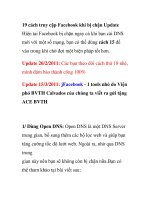03 pricing update
Bạn đang xem bản rút gọn của tài liệu. Xem và tải ngay bản đầy đủ của tài liệu tại đây (25.75 MB, 34 trang )
Electronic Commerce
Chapter3:Pricing&revenue
models
Email:
Objectives
•
•
•
•
•
Factors affecting pricing
Determining price
Dynamic pricing
Auctions
Revenue models
Factorsaffectingpricing
• Factors affecting pricing
• Demand
Factorsaffectingpricing
• Factors affecting pricing
• Elasticity
Factorsaffectingpricing
• Factors affecting pricing
• Market structure
• Recession
• Production cost
Determiningprice
• Game theory model
• Consists of: players, strategies, payoffs
• Prisoners' dilemma
Determiningprice
• Game theory model
• A player’s best response is the strategy that maximizes the
player’s payoff, given the strategies of the other players
• A strategy is a dominant strategy for a firm if it is optimal, no
matter what strategy is used by the other players
• The firms are in a Nash Equilibrium if the strategy of each firm is
the best response to the strategies of the other firms.
Equivalently, in a Nash equilibrium, none of the firms have any
incentive to unilaterally deviate from its strategy
Determiningprice
• Game theory model
• Companies A and B both produce phones
• What price companies A and B will set for their phones?
Determiningprice
• Game theory model
• Companies A and B both produce phones
DISCUSSION
Dynamicpricing
• Determining the right prices to charge a customer for a
product or a service: complex task
• Customers’ information is increasingly recorded with the
advances of the Internet and e-commerce technologies
• The cost of changing products’ prices: menu cost
• Is very large for companies with many products and services
• Reduced significantly in e-commerce
Dynamicpricing
• Definitions
• Price dispersion
• Price discrimination
• Price dispersion
• Spatial
• Temporal
• Price discrimination
• First degree (perfect) differentiation: different prices for different
units sold and people
• Second degree price differentiation: different prices for different
units sold
• Third degree price differentiation: different prices for different
people
Dynamicpricing
• Price differentiation through product differentiation
• Dell computer
• Dynamic pricing methods
• Posted price mechanism
• Price discovery mechanism
• Example of dynamic pricing: airline industry
• Consumer segmentation
• Business class: date and time are more important
• Economy class: fare is more important
• Available seats adjustment in specific periods
Auctions
• From Babylon to the Roman Empire to Buddhists
• Auction: seller offering item for sale
•
•
•
•
•
Bids: price potential buyer willing to pay
Bidders: potential buyers
Private valuations: amounts bidders willing to pay
Auctioneer: manages auction process
Shill bidders: bidder who seller or auctioneer employees
Auctions
• English auctions
• Bidders publicly announce their successive higher bids until no
higher bid is forthcoming
• The item sold to the highest bidder at that bidder’s price
• Known as
• Ascending-price auction
• Open auction (open-outcry auction)
• Minimum bid
• The price at which an auction begins
• If not met: item removed (not sold)
Auctions
• English auctions
• Reserve price
• Seller’s minimum acceptable price
• Not announced
• If not exceeded: item withdrawn (not sold)
• Yankee auctions
• Multiple items are offered
• Highest bidder allotted bid quantity
• Remaining items allocated to next highest bidders until all items
distributed
• Bidders pay lowest successful bidder price
Auctions
• English auctions
• English auction seller drawback
• May not obtain maximum possible price
• English auction buyer drawback
• Winner’s Curse
• Psychological phenomenon
• Caught up in competitive bidding excitement
• Bidders risk bidding more than their private valuations
Auctions
• Dutch auctions
• Open auction
• Bidding starts at a high price
• Drops until bidder accepts price
• Also called descending-price auctions
• Seller offers number of similar items for sale
• Common implementation
• Use a clock (price drops with each tick)
• If items remain: clock restarted
Auctions
• Dutch auctions
• Advantages
• Seller obtains close to highest private valuation
• Quickly move large numbers of commodity items
• Disadvantages
• Sales or product interest generated: does not justify cost of
operation
• Customer confusion
• Successful examples
• Google initial public offering stock sale (2004)
Auctions
• Sealed-bid auctions
• Bidders submit bids independently
• Prohibited from sharing information
• First-price sealed-bid auction
• Highest bidder wins
• If multiple items auctioned: next highest bidders awarded
remaining items at their bid price
• Second-price sealed-bid auction (Vickrey auctions)
• Highest bidder awarded item at second-highest bidder price
• William Vickrey: 1996 Nobel Prize in Economics
Auctions
• Double Auctions
•
•
•
•
Sealed bid or open outcry
Good for: items of known quality traded in large quantities
No item inspection before bidding
Auctioneer
• Matches sellers’ offers starting with lowest price and then goes up
• To buyers’ offers starting with highest price and then goes down until
all quantities offered are sold
• Example: New York Stock Exchange
Auctions
• Reverse (Seller Bid) Auctions
• Multiple sellers submit price bids
• Auctioneer represents single buyer
• Bids for given amount of specific item to purchase
• Prices go down as bidding continues
• Until no seller is willing to bid lower
• Used by consumers
• Largest dollar volume
• Businesses: both buyers and sellers
• Buyer acts as auctioneer
• Screens sellers before participation
Auctions
Revenuemodels
• Revenue model: how businesses generate revenue?
•
•
•
•
•
•
Web catalog
Digital content
Advertising-supported
Advertising-subscription mixed
Fee-for-transaction
Fee-for-service
• These models are not exclusive and can combine together
• Work for both B2B and B2C categories
Revenuemodels
• Web catalog
• Adapted from traditional catalog-based model
• Seller established brand image
• Sold through printed information mailed to prospective buyers
• Web sites expand traditional model
• Replace or supplement print catalogs
• Offer flexibility
• Order through Web site or telephone
• Payment though Web site, telephone, or mail
• Creates additional sales outlet
• Suitable for: computers and consumer electronics, books, music,
videos, luxury goods, clothing retailers, etc.
Revenuemodels
• Digital content
• Sell subscriptions for access to the information
• Most of these digital content providers specialize in legal,
academic research, business, or technical material
• Advertising-Supported
• Free content with advertising messages
• Stickiness
• Keeping visitors at site and attracting repeat visitors
• Exposed to more advertising in sticky site
• Large visitors vs. targeted visitors (demographic information)
• Web portal: Yahoo!









